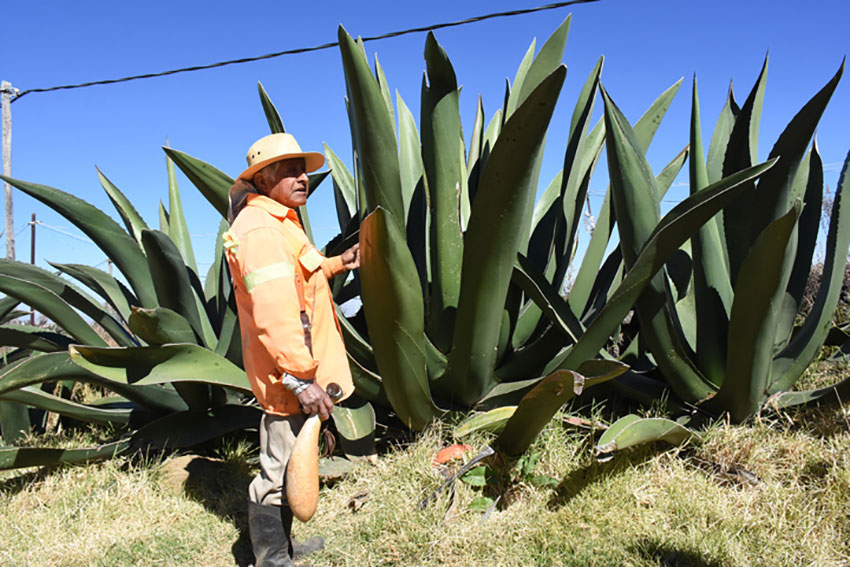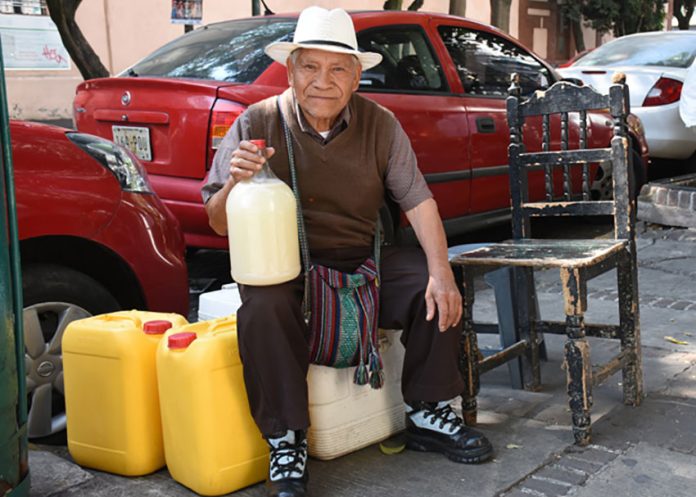Pedro García, more commonly known as Don Pedro, dips a plastic pitcher into a large blue barrel filled to the brim with pulque, a milky, mildly alcoholic drink made from the juice of the maguey plant.
He’s been making pulque in San Pablo Oztotepec, a pueblo in the southernmost part of Mexico City, for about 10 years after learning how from his father. He fills glasses for his two guests, one of whom is a young man.
“This is an aphrodisiac,” Don Pedro tells him with a wink and a sly smile. “If a young man drinks this, he will have a baby within a year.” Then, realizing that his other guest wasn’t so young, leans towards him and whispers, “This is better than Viagra.”
Those statements may be apocryphal, and may not be the main reasons behind pulque’s resurgence, but the drink’s definitely making a comeback in Mexico.
Pulque is made from the same plant as mezcal and tequila, but it’s fermented while the other liquors are distilled. Like many things in Mexico, pulque has a long history and, also like many things here, the Spanish did their best to get rid of it.

There are a number of Aztec gods and legends associated with pulque. Mayahuel, the goddess of maguey, is also sometimes identified as the goddess of pulque. She’s often depicted emerging from a maguey plant with a cup of pulque in her hand. Some sources name Tepoztécatl, one of her sons, as the god of pulque (El Tepozteco, a temple on a hill in Tepoztlán, a lovely pueblo in Morelos, is dedicated to him).
Some of the confusion may be due to the fact that Mayahuel had 400 children, most of whom were males, and were also involved in some way with pulque and intoxication. Whoever discovered it and however it got here, it’s been around a long time. Evidence points to it originating with the Otomís, as long ago as 2000 B.C.
In pre-Hispanic times, pulque had many functions. It provided nutrition, was used in religious ceremonies, as medicine and in special events, like weddings and feasts honoring warriors. It was also given to the priests performing human sacrifices and also to the victims. But it began to fall out of favor with the arrival of the Spanish.
Although they did not ban it outright, the Spanish did their best to discourage its consumption, seeing it as unclean and something that was corrupting indigenous populations. The biggest threat came in the late 19th century when German brewers arrived in Mexico and a campaign was begun to promote beer and denigrate pulque.
Rumors spread that pulque was made using a muneca, a cloth bag filled with excrement. “That was a myth,” said Javier Francisco Zarza Ramírez, owner of 5 Monas, a pulquería in Coyoacán, Mexico City. “It was created so that beer companies could take over a lot of territory from pulque.”
Still, many people apparently decided not to take any chances and, seeing beer as something European, modern and perhaps more hygienic, turned to it for refreshment. But recently, more Mexicans, especially younger ones, have discovered pulque, partly because of its strong connection to Aztec culture and its health benefits.
If there’s one thing that Don Pedro and other pulque makers (called clachiqueros) need to have, it’s an abundance of patience. “It takes 20 years or more for a maguey plant to mature,” he said. At that point he can begin making pulque from it but there are several steps and a wait of another year before that can happen.
“When the leaves are thin,” he said, “the plant is ready.” He first cuts away the leaves surrounding the heart of the maguey (they’re used for barbacoa), scrapes the heart with a tool called a raspador and places a stone on top of the heart. “This is to prevent water from getting in. Then you wait a year. It is important to wait.”
After a year, the heart is scraped out again and the plant starts producing aguamiel (honey water); this is non-alcoholic and drunk for its medicinal properties. “At first, there are only one or two glasses a day,” he explained. “Then it increases after a month or two.” A large plant produces nine liters a day and he collects the aguamiel twice a day, sucking it out using an acocote, a traditional tool made from a gourd. Typically, after about six months, the plant dies.
The collected aguamiel is poured into a large container and although it already contains bacteria and yeast that will cause fermentation, clachiqueros add starter or seed pulque to hasten the process. “It takes only one day for the aguamiel to ferment and make pulque,” he said. “It will be sweet for one or two days and after that it is stronger but the flavor is not as good. The flavor changes as the plant ages. It is like wine. There is pulque in Hidalgo but ours is better because the soil is sweet.”
People bring their own bottles to Don Pedro, which he fills for 20 pesos (about US $1). Since the pulque continues to ferment, it’s critical to keep the cap loose to avoid an explosion. The beverage can be found in almost all of the small pueblos surrounding Mexico City but there’s no need to make the trip as it can be readily found in the city.
Patricio González Librado has been selling pulque on a street corner across from the Coyoacan Market for 15 years and readily extols its many virtues. “People like it because it is natural,” he said. “It cures gastritis and other stomach problems and cleans the lungs. I drink a glass at lunch and another at dinner.”

For those who prefer to enjoy their pulque inside, there are many pulquerías to choose from.
5 Monas, in Coyoacán, typically has a dozen different flavored pulques — called curados — sitting in jars on the bar and a barrel of unflavored pulque — called naturál – behind the bar. “Young people prefer curado,” said owner Javier Zarza, “although some adults will mix a little curado with naturál. Also, adults will drink it if they feel sick.”
A number of studies have shown that pulque does, indeed, have nutritional and medicinal properties. It’s a rich source of several vitamins, minerals and proteins. A study of the Otomís, an indigenous group in Hidalgo, found that pulque consumption was their second most important source of nutrition after tortillas. It lowers cholesterol and stimulates the immune system and has also been used to treat gastrointestinal diseases. But, of course, not everyone drinks it for its health benefits.
“Pulque makes me happy but doesn’t bother my stomach,” said Emilio Patino. “With alcohol, if you drink too much, you get a headache the next day. With pulque, you get drunk but you don’t get a headache the next day.”
He took a sip of his pulque naturál. “Pulque, corn, tacos pastor, tequila, these are all things that define Mexico.”
The writer is a frequent contributor to Mexico News Daily. He lives in San Gregorio Atlapulco, Mexico City.
